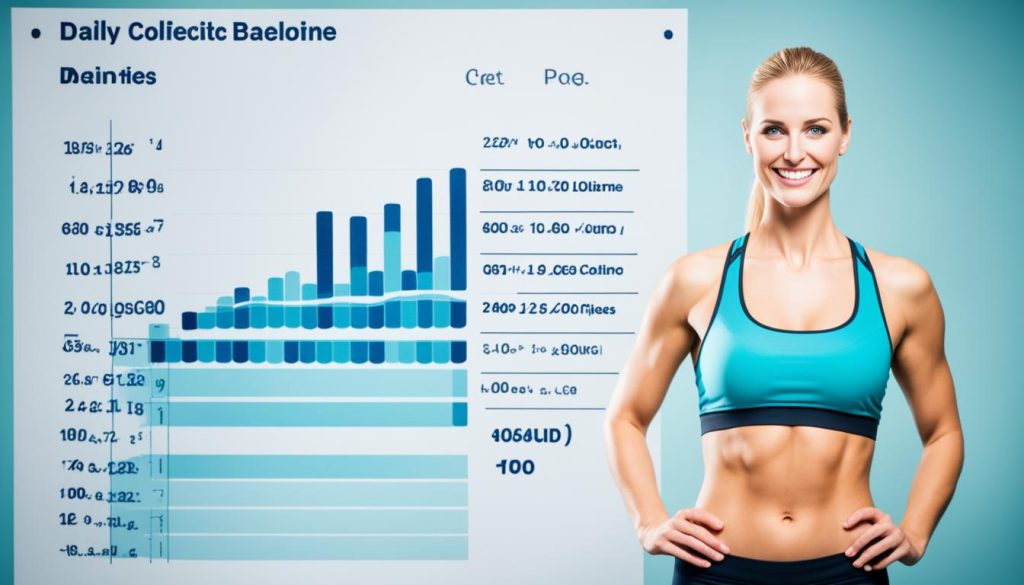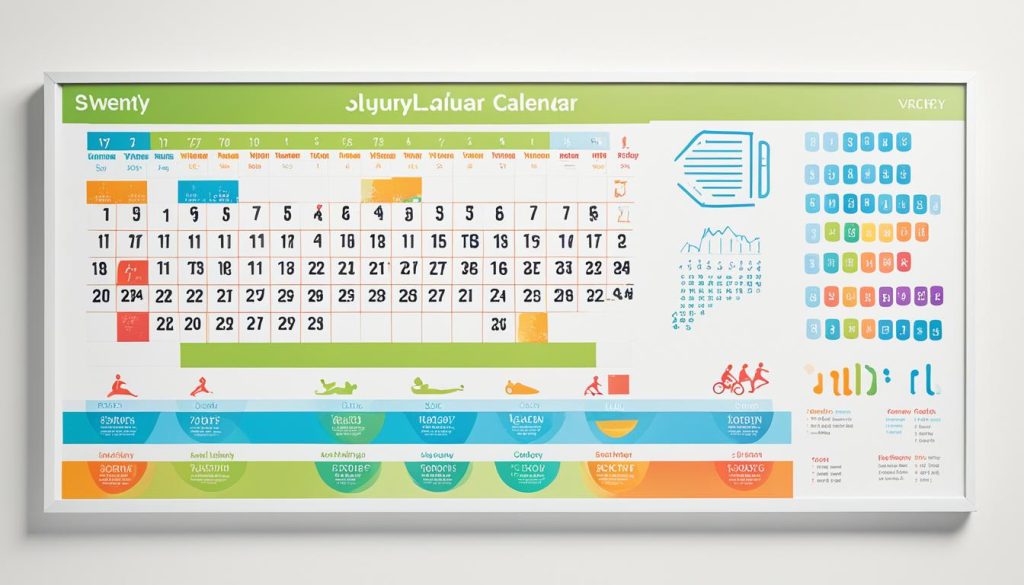Welcome to our comprehensive guide on how many calories you should burn a day to lose weight. If you’re looking to shed those extra pounds and achieve your weight loss goals, understanding the role of daily calorie burn is crucial. By creating a calorie deficit through a combination of diet and exercise, you can pave the way to a healthier, fitter you.
Calories burned to lose weight depend on several factors, such as your weight-loss goals, calorie deficit, and physical activity level. To lose 1 to 2 pounds per week, you’ll need to burn 500 to 1,000 calories more than you consume each day. By knowing your daily calorie burn, you can effectively plan your weight loss journey.
How Many Calories Should I Burn a Day to Lose Weight?
Calculating your daily calorie burn might seem daunting, but fear not! Our guide will walk you through the process. We’ll explore how to calculate your overall daily calorie burn, delve into the factors that influence it, and provide tips to help you burn more calories during your workouts.
But first, let’s dive into the question that brought you here: how many calories should you burn a day to lose weight? This knowledge will serve as the cornerstone of your weight loss plan, enabling you to set realistic weight loss calorie goals and create a sustainable calorie deficit to achieve your desired results.
How to Calculate Your Daily Calorie Burn?
Your daily calorie burn is influenced by several factors, including your age, height, weight, muscle mass, and level of physical activity. While there are formulas available to calculate your exact total daily energy expenditure (TDEE), a simpler method based on body weight can serve as a starting point. On average, the daily calories burned range from 15-16 per pound of body weight, with 12-13 calories needed for weight loss and 18-19 calories needed for weight gain.
To determine your daily calorie burn, follow these steps:
-
- Calculate your basal metabolic rate (BMR) using a formula such as the Harris-Benedict equation:
BMR for men = 66 + (6.23 × weight in pounds) + (12.7 × height in inches) – (6.8 × age in years)
BMR for women = 655 + (4.35 × weight in pounds) + (4.7 × height in inches) – (4.7 × age in years)
- Adjust your BMR based on your activity level:
- Sedentary (little or no exercise): BMR × 1.2
- Lightly active (light exercise/sports 1-3 days/week): BMR × 1.375
- Moderately active (moderate exercise/sports 3-5 days/week): BMR × 1.55
- Very active (hard exercise/sports 6-7 days a week): BMR × 1.725
- Extra active (very hard exercise/sports & physical job or 2x training): BMR × 1.9
- Based on your calculated TDEE, determine the appropriate calorie intake for your weight goals:
- To maintain weight: TDEE
- To lose weight: TDEE – 500 to 1,000 calories per day
- To gain weight: TDEE + 500 to 1,000 calories per day
Example Calculation
Let’s say you’re a 35-year-old woman who weighs 150 pounds, is 5 feet 6 inches tall, and exercises moderately 3-5 days a week. Here’s how you would calculate your daily calorie burn:
BMR = 655 + (4.35 × 150) + (4.7 × 66) – (4.7 × 35) = 1,455.5 calories
TDEE = BMR × 1.55 = 1,455.5 × 1.55 = 2,255.03 calories
To lose weight, you would consume 1,255.03 to 1,755.03 calories per day.

Factors Affecting Daily Calorie Burn
To get a more accurate idea of your total daily energy expenditure (TDEE), it’s important to consider factors that affect your daily calorie burn. These factors include your resting metabolic rate (RMR), which is the number of calories your body needs at rest, the thermic effect of food (TEF), which is the calories burned during digestion and absorption of nutrients, nonexercise activity thermogenesis (NEAT), which is the calories burned through daily activities, and calories burned during exercise.
Resting Metabolic Rate (RMR)
Your resting metabolic rate (RMR) is the number of calories your body needs to perform basic functions and maintain vital organs while at rest. It accounts for the majority of your total daily energy expenditure (TDEE). Several factors influence your RMR, including age, gender, body composition, and genetics. The higher your RMR, the more calories your body burns at rest.
Thermic Effect of Food (TEF)
The thermic effect of food (TEF) refers to the energy expenditure required for the digestion, absorption, and storage of nutrients. Different macronutrients have different thermic effects, with proteins requiring the most energy to digest and fats requiring the least. On average, TEF contributes to about 10% of your total daily calorie burn.
Nonexercise Activity Thermogenesis (NEAT)
Nonexercise activity thermogenesis (NEAT) refers to the calories burned through daily activities that are not considered exercise. This includes activities like walking, standing, fidgeting, and household chores. NEAT can vary significantly between individuals based on occupation, lifestyle, and activity level. Increasing NEAT can be an effective way to boost daily calorie burn.
Calories Burned During Exercise
Calories burned during exercise vary depending on the type of activity, duration, intensity, and individual factors such as weight and fitness level. Engaging in regular exercise and incorporating a combination of cardiovascular exercises and strength training can help increase your overall calorie burn and support weight loss goals.

| Factors | Description |
|---|---|
| Resting Metabolic Rate (RMR) | The number of calories your body needs at rest. Influenced by age, gender, body composition, and genetics. |
| Thermic Effect of Food (TEF) | The calories burned during digestion, absorption, and storage of nutrients. Varies based on macronutrient composition. |
| Nonexercise Activity Thermogenesis (NEAT) | The calories burned through daily activities that are not considered exercise, such as walking, standing, and household chores. |
| Calories Burned During Exercise | The calories burned during structured exercise activities, including cardiovascular exercises and strength training. |
How to Calculate Your Weekly Calorie Burn?
Calculating your weekly calorie burn is an important step in managing your weight loss journey. By understanding how many calories you burn in a week, you can adjust your diet and exercise routine accordingly to achieve your desired results.
To calculate your weekly calorie burn, you first need to determine your daily calorie burn. This can be done by calculating your resting metabolic rate (RMR) and factoring in your activity level. Here’s how:
Step 1: Determine your resting metabolic rate (RMR) – This is the number of calories your body needs at rest to maintain basic bodily functions. To estimate your RMR, you can use the Harris-Benedict equation:
| Activity Level | Formula |
|---|---|
| Sedentary (little to no exercise) | RMR x 1.2 |
| Lightly Active (light exercise or sports 1-3 days a week) | RMR x 1.375 |
| Moderately Active (moderate exercise or sports 3-5 days a week) | RMR x 1.55 |
| Very Active (hard exercise or sports 6-7 days a week) | RMR x 1.725 |
| Extra Active (very hard exercise or physical job, training twice a day) | RMR x 1.9 |
Step 2: Multiply your RMR by your activity level to get your estimated total daily energy expenditure (TDEE).
Step 3: Multiply your daily calorie burn by 7 to scale it to a week. This will give you an estimate of your weekly calorie burn.
Once you have calculated your weekly calorie burn, you can use this information to adjust your weight loss plan. For example, if your goal is to lose weight, you can aim to create a calorie deficit by consuming fewer calories than your weekly calorie burn. This deficit will result in weight loss over time.
Remember, it’s important to consider your activity level when calculating your weekly calorie burn. If you lead an active lifestyle or engage in regular exercise, your calorie burn may be higher compared to someone who is more sedentary. By understanding your weekly calorie burn, you can make informed decisions about your diet and exercise routine to support your weight loss goals.
So, take the time to calculate your weekly calorie burn and use this valuable information to guide your weight loss journey. With the right knowledge and determination, you can achieve the results you desire.

How to Calculate Your Calories for Weight Loss?
To achieve weight loss, it’s important to create a calorie deficit. This means consuming fewer calories than your body needs to maintain its current weight. By calculating your total daily energy expenditure (TDEE) and adjusting your calorie intake accordingly, you can effectively achieve your weight loss goals.
To calculate your calories for weight loss, follow these steps:
Step 1: Determine Your Total Daily Energy Expenditure (TDEE)
Your TDEE is the total number of calories your body burns in a day, taking into account your basal metabolic rate (BMR) and physical activity level. There are various formulas you can use to calculate your TDEE, such as the Harris-Benedict equation or the Mifflin-St. Jeor equation. These formulas consider factors such as your age, sex, weight, and activity level.
Alternatively, you can use online calculators or fitness trackers that provide an estimate of your TDEE based on your inputs.
Step 2: Create a Calorie Deficit
To lose weight, you’ll need to create a calorie deficit by consuming fewer calories than your TDEE. A calorie deficit of 500 to 1,000 calories per day is generally recommended for a safe and sustainable weight loss of 1 to 2 pounds per week.
For example, if your TDEE is calculated to be 2,000 calories per day, you would aim to consume 1,500 to 1,000 calories per day to create a calorie deficit of 500 to 1,000 calories.
Step 3: Monitor and Adjust Your Calorie Intake
Tracking your calorie intake is essential for effective weight loss. Keep a food diary or use mobile apps to track your daily calorie consumption. This will help you stay accountable and make adjustments if necessary.
If you’re not losing weight at the desired rate, you can further adjust your calorie intake. However, it’s important to avoid drastic calorie deficits, as they can lead to nutrient deficiencies and muscle loss. Aim for a gradual and sustainable weight loss approach.
Remember that weight loss is a journey, and individual results may vary. Consulting with a healthcare professional or registered dietitian can provide personalized guidance and recommendations based on your specific needs and goals.
| Calorie Calculation Steps | Summary |
|---|---|
| Determine Your TDEE | Use formulas or online calculators to estimate your TDEE based on factors such as age, sex, weight, and activity level. |
| Create a Calorie Deficit | Consume fewer calories than your TDEE, aiming for a deficit of 500 to 1,000 calories per day. |
| Monitor and Adjust | Track your calorie intake and make adjustments if needed. Avoid drastic deficits for sustainable weight loss. |
By calculating your calories for weight loss and making necessary adjustments, you can effectively create a calorie deficit and work towards achieving your weight loss goals. Remember to combine this approach with a balanced diet and regular physical activity for optimal results.
How to Burn More Calories During a Workout?
The number of calories you burn during a workout depends on various factors, including your weight, sex, age, and intensity of the workout. To burn more calories, you can focus on increasing the intensity and duration of your workouts. Incorporating both cardio and strength training exercises can help boost your calorie burn. Monitoring your heart rate training zone can also help optimize your workouts for calorie burn.
Increasing the intensity and duration of your workouts is an effective way to burn more calories. By pushing yourself to work harder and for longer periods, you’ll increase the overall energy expenditure of your workout. This can be achieved by performing more challenging exercises, increasing the weight or resistance, or adding intervals of high-intensity exercises.
Cardiovascular exercises are great for burning calories. Activities such as running, cycling, swimming, and aerobic classes can significantly increase your calorie burn. These exercises elevate your heart rate and engage large muscle groups, resulting in a higher calorie expenditure.
Strength training is also important for increasing calorie burn. While strength training may not burn as many calories during the workout itself, it helps build muscle mass. Increasing your muscle mass can raise your resting metabolic rate (RMR), meaning you burn more calories even at rest.
Variety and Different Types of Workouts
Adding variety to your workouts can also help maximize calorie burn. Your body adapts to repetitive exercises, making them less challenging over time. By incorporating different types of workouts, you can keep your body guessing and increase your calorie burn.
For example, you can alternate between cardio workouts like running or cycling, and strength training workouts using weights or resistance bands. This combination of exercises targets different muscle groups and keeps your body stimulated, resulting in increased calorie burn.
Here’s a table showing the estimated calorie burn for various types of workouts:
| Workout Type | Calories Burned per Hour |
|---|---|
| Running (8 mph) | 861 |
| Cycling (14-16 mph) | 672 |
| Aerobics (high impact) | 533 |
| Weightlifting (vigorous effort) | 365 |
| Yoga (vinyasa flow) | 298 |
Remember, these are average values and can vary depending on factors such as body weight and effort exerted. However, they provide a general idea of the calorie burn for different types of workouts.
Monitoring your heart rate training zone can also be helpful in optimizing calorie burn during workouts. Your heart rate training zone is the range of heartbeats per minute that enables efficient calorie burning. Exercising within this zone ensures that you’re working at an intensity that maximizes fat burning and calorie expenditure.
To determine your heart rate training zone, calculate your maximum heart rate by subtracting your age from 220. Then, aim to exercise at a intensity that falls within 50% to 85% of your maximum heart rate. This will help you achieve the optimal balance between calorie burn and endurance.
By incorporating these strategies into your workouts, you can increase your calorie burn and make your exercise routine more effective for weight loss.

Conclusion
Achieving weight loss success requires finding the right balance of calorie burn and calorie intake. By calculating your daily calorie burn and creating a healthy calorie deficit, you can set yourself up for effective weight loss. Incorporating calorie burn strategies into your workouts can also enhance your progress and help you reach your goals.
Remember that maintaining a healthy calorie deficit is essential for sustainable weight loss. It’s important to consult with a healthcare professional or registered dietitian who can provide personalized recommendations based on your individual needs and goals. They can guide you towards the most effective weight loss strategies and ensure that you’re meeting your nutritional requirements.
Whether it’s through cardio exercises, strength training, or a combination of both, finding the right workout routine that increases your calorie burn is crucial. Focusing on intensity, duration, and variety can optimize your calorie burn during each workout session. Additionally, monitoring your heart rate training zone can help you tailor your workouts to maximize calorie burn.
By implementing these strategies and maintaining a healthy balance between calorie burn and intake, you can achieve your weight loss goals in a sustainable and efficient manner. Remember that effective weight loss is a gradual process, and it’s important to prioritize your overall health and well-being. With determination, consistency, and professional guidance, you can embark on a successful weight loss journey.




